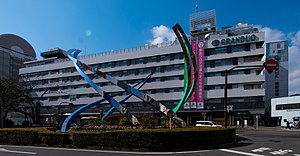Kamata_Station_(Tokyo)
Kamata Station (Tokyo)
Railway station in Tokyo, Japan
JK17 IK15 TM07 Kamata Station 蒲田駅 | ||||||||||||||||||||||||||||
|---|---|---|---|---|---|---|---|---|---|---|---|---|---|---|---|---|---|---|---|---|---|---|---|---|---|---|---|---|
 The station building in February 2018 | ||||||||||||||||||||||||||||
| General information | ||||||||||||||||||||||||||||
| Location | Ōta, Tokyo Japan | |||||||||||||||||||||||||||
| Operated by | ||||||||||||||||||||||||||||
| Line(s) | ||||||||||||||||||||||||||||
| Connections | ||||||||||||||||||||||||||||
| Other information | ||||||||||||||||||||||||||||
| Station code | JK17, IK15, TM07 | |||||||||||||||||||||||||||
| History | ||||||||||||||||||||||||||||
| Opened | 11 April 1904; 120 years ago (11 April 1904) | |||||||||||||||||||||||||||
| Passengers | ||||||||||||||||||||||||||||
| JR East, FY2013 | 139,728 daily | |||||||||||||||||||||||||||
| ||||||||||||||||||||||||||||
| ||||||||||||||||||||||||||||
Kamata Station (Japanese: 蒲田駅,Japanese pronunciation: [Kamata-eki]) is a railway station in Ōta, Tokyo, Japan, operated by the East Japan Railway Company (JR East) and the private railway operator Tokyu Corporation.
Kamata Station is served by the following lines:
Keikyu Kamata Station on the Keikyu Main Line is located about 700 m to the east of Kamata Station. The Tōkaidō Main Line also runs adjacent to the station on the outer tracks without stopping.
JR East
The JR East station is a surface station with platforms in a north–south direction.
Platforms
| 1-2 | JK Keihin-Tohoku Line | for Kawasaki, Yokohama, and Ōfuna |
| 3-4 | JK Keihin-Tohoku Line | for Tokyo, Akabane, and Ōmiya |
Tokyu
The Tokyu station is located to the southwest corner of the JR station.
Platforms
| 1 | IK Tokyu Ikegami Line | for Ikegami, Yukigaya-Ōtsuka, Hatanodai, and Gotanda |
| 2 | IK Tokyu Ikegami Line | for Ikegami, Yukigaya-Ōtsuka, Hatanodai, and Gotanda |
| TM Tokyu Tamagawa Line | for Shimo-Maruko and Tamagawa | |
| 3-4 | TM Tokyu Tamagawa Line | for Shimo-Maruko and Tamagawa |
The JR East station opened on 11 April 1904.[1] The Tokyu station opened on 6 October 1922 on the Ikegami Line, and services on Tamagawa Line began on 1 November 1923.[2]
Plans exist to build a Kama-Kama Line that would extend the Tokyu Tamagawa Line from Kamata eastward by approximately 800 m to Keikyu Kamata Station on the Keikyu Main Line and Keikyu Airport Line. This would provide an interchange between the lines, improving accessibility to Tokyo's Haneda Airport ahead of the 2020 Summer Olympics.[3] As of June 2022[update], Ōta Ward has agreed with the Tokyo Metropolitan Government to pay 70% of the project cost of ¥136 billion (2021) (US$1.24 billion) while having the city government responsible for the remaining 30%.[4]
In fiscal 2013, the JR East station was used by an average of 139,728 passengers daily (boarding passengers only), making it the nineteenth-busiest station operated by JR East.[5] Over the same fiscal year the Tōkyū Ikegami and Tamagawa Line stations were used by an average of 69,464 and 88,102 passengers daily respectively (entering and exiting passengers).[6]
The passenger figures for previous years are as shown below.
| Fiscal year | JR East | Tokyu | |
|---|---|---|---|
| Ikegami Line | Tamagawa Line | ||
| 2000 | 129,724[7] | ||
| 2005 | 131,947[8] | 64,664[9] | 82,890[9] |
| 2010 | 133,748[10] | 67,873[11] | 84,399[11] |
| 2011 | 133,593[12] | 67,171[13] | 84,269[13] |
| 2012 | 135,668[14] | 68,143[15] | 85,300[15] |
| 2013 | 139,728[5] | 69,464[6] | 88,102[6] |
- Note that JR East figures are for boarding passengers only.
- 日本国有鉄道停車場一覧 [JNR Station Directory]. Japan: Japanese National Railways. 1985. p. 19. ISBN 4-533-00503-9.
- Terada, Hirokazu (19 January 2013). データブック日本の私鉄 [Databook: Japan's Private Railways]. Japan: Neko Publishing. p. 231. ISBN 978-4-7770-1336-4.
- "Rail extension eyed to boost Haneda accessibility". The Japan Times. Japan: The Japan Times Ltd. 29 July 2014. p. 7. Retrieved 29 July 2014.
- "蒲田駅と京急蒲田駅を結ぶ鉄道の事業化に前進 東京 大田区|NHK 首都圏のニュース" [Advance to commercialization of railway connecting Kamata Station and Keikyu Kamata Station Ota-ku, Tokyo]. NHK Web (in Japanese). 6 June 2022. Retrieved 6 June 2022.
- 各駅の乗車人員 (2013年度) [Station passenger figures (Fiscal 2013)] (in Japanese). Japan: East Japan Railway Company. Archived from the original on 6 May 2001. Retrieved 2 September 2014.
- 2013年度乗降人員 [2013 Station passenger figures] (in Japanese). Japan: Tokyū Corporation. 4 June 2014. Retrieved 2 September 2014.
- 各駅の乗車人員 (2000年度) [Station passenger figures (Fiscal 2000)] (in Japanese). Japan: East Japan Railway Company. Archived from the original on 9 October 2014. Retrieved 2 September 2014.
- 各駅の乗車人員 (2005年度) [Station passenger figures (Fiscal 2005)] (in Japanese). Japan: East Japan Railway Company. Archived from the original on 9 October 2014. Retrieved 2 September 2014.
- 2005年度乗降人員 [2005 Station passenger figures] (in Japanese). Japan: Tokyu Corporation. 19 May 2006. Retrieved 2 September 2014.
- 各駅の乗車人員 (2010年度) [Station passenger figures (Fiscal 2010)] (in Japanese). Japan: East Japan Railway Company. Archived from the original on 6 October 2014. Retrieved 2 September 2014.
- 2010年度乗降人員 [2010 Station passenger figures] (in Japanese). Japan: Tokyu Corporation. 19 May 2011. Retrieved 2 September 2014.
- 各駅の乗車人員 (2011年度) [Station passenger figures (Fiscal 2011)] (in Japanese). Japan: East Japan Railway Company. Archived from the original on 8 October 2014. Retrieved 2 September 2014.
- 2011年度乗降人員 [2011 Station passenger figures] (in Japanese). Japan: Tokyu Corporation. 15 May 2012. Retrieved 2 September 2014.
- 各駅の乗車人員 (2012年度) [Station passenger figures (Fiscal 2012)] (in Japanese). Japan: East Japan Railway Company. Archived from the original on 7 October 2014. Retrieved 2 September 2014.
- 2012年度乗降人員 [2012 Station passenger figures] (in Japanese). Japan: Tokyu Corporation. 29 May 2013. Retrieved 2 September 2014.
- Kamata Station (JR East) (in Japanese)
- Kamata Station (Tokyu) (in Japanese)



